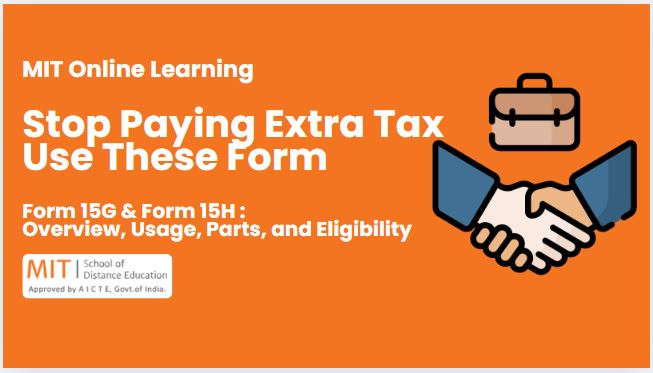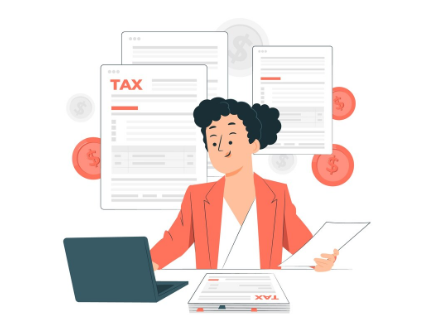
In India, understanding how to manage taxes effectively can save you from unnecessary financial deductions. Two crucial tools for this purpose are Form 15G and Form 15H. These forms allow eligible individuals to request exemption from Tax Deducted at Source (TDS) on interest income if their total taxable income is below the exemption limit.
Whether you’re an aspiring finance professional or currently pursuing a PG diploma in finance, mastering the usage and purpose of these forms can give you a significant edge. Not only do they help you manage your finances more efficiently, but they also form a critical part of practical learning in finance management programs, such as a diploma in finance or PGDM in finance distance learning.
What Are Form 15G and Form 15H?
Both Form 15G and Form 15H are self-declaration documents that can be submitted to banks and other financial bodies to prevent TDS on interest income. Typically, banks are required to deduct TDS when the annual interest earned exceeds ₹40,000 (₹50,000 for senior citizens). However, if your total income falls below the taxable limit, you are not liable to pay any tax and can use these forms to ensure your interest income is not subjected to TDS.
Form 15G is meant for individuals below 60 years of age.
Form 15H is designed for senior citizens aged 60 years or more.
These forms are widely used in fixed deposit accounts, recurring deposits, post office savings, and other income-generating investments. 
Why Are These Forms Important?
Avoiding TDS through Form 15G or 15H is a smarter financial move if your income is non-taxable. Without these forms, TDS may be deducted even if you are not liable to pay tax, and you’ll have to claim a refund by filing an income tax return (ITR). For students or professionals pursuing online PGDM finance courses, understanding such practical tax-saving techniques enhances financial literacy and prepares you for real-world challenges.
Who Can Use Form 15G?
To be eligible to submit Form 15G, you must meet the following criteria:
You must be an individual or HUF (Hindu Undivided Family), not a company or firm.
Your age should be below 60 years.
You must be a resident of India.
Your total income should be below the taxable threshold (currently ₹2.5 lakh).
The total interest income for the year should not exceed the basic exemption limit.
If you fulfill all these conditions, Form 15G is the right form to avoid TDS on your interest income.
Who Can Use Form 15H?
Form 15H is available only to senior citizens (aged 60 or above). Here are the eligibility conditions:
The individual must be a resident of India.
Age should be 60 years or older during the financial year.
The total tax liability should be nil.
The income earned from interest should not make your total income taxable.
For example, if a 65-year-old individual earns ₹3 lakh from a fixed deposit but has no other income, they can use Form 15H to prevent TDS deduction.
Key Differences Between Form 15G and 15H
| Feature | Form 15G | Form 15H |
|---|---|---|
| Applicable To | Individuals below 60 years | Senior citizens (60+ years) |
| Taxable Income Limit | Below ₹2.5 lakh | Below ₹3 lakh (60-79 yrs), ₹5 lakh (80+ yrs) |
| TDS Avoidance | Yes, if criteria met | Yes, if criteria met |
| Eligible Entities | Individuals, HUFs | Resident individuals only |
Where Can You Submit These Forms?
Forms 15G and 15H are typically submitted to:
Banks and NBFCs for fixed deposits and recurring deposit accounts.
Post offices if you’re earning interest above the threshold.
EPFO (Employees’ Provident Fund Organisation) for EPF withdrawals before five years of service.
LIC and other insurance companies where maturity proceeds could attract TDS.
Corporate bond issuers where interest income may exceed ₹5,000 annually.
Structure of the Forms
Part I – To Be Filled by the Declarant:
Name, PAN, Address
Status (Individual/HUF)
Previous year details
Estimated total income
Details of income for which form is submitted
Declaration and signature
Part II – To Be Filled by the Institution:
Details of the income paid or credited
TAN of the institution
Verification and acknowledgment
The forms are available both online and offline. Most banks now allow digital submission through internet banking platforms.
When to Submit Form 15G/15H?
These forms should ideally be submitted at the beginning of the financial year to ensure that no TDS is deducted on your interest income from the start. Submitting them late may result in TDS already being deducted, which you’ll then have to claim through an ITR.

Benefits for Finance Students and Professionals
For learners pursuing a top PGDM finance management course, these forms present real-life examples of income tax compliance. Understanding when and how to use them is crucial for advising clients, managing personal finance, or working in financial planning and consulting roles.
Let’s take an example. A finance student interning with a bank may be tasked with verifying Form 15G submissions. Knowing eligibility criteria and tax exemptions helps ensure compliance and accuracy.
Moreover, knowledge of tax-related documentation like these is extremely helpful in courses such as:
PG diploma in finance
Diploma in finance
PGDM in finance distance learning
Online PGDM finance programs
Such understanding not only adds to theoretical knowledge but also builds confidence in handling client portfolios and advising on investment planning.
Common Mistakes to Avoid
Submitting the wrong form: Make sure you meet all the eligibility criteria for Form 15G or 15H before submission.
Not including PAN: Failure to quote PAN will result in a higher TDS rate of 20%.
Not submitting on time: Late submission means you may not avoid TDS already deducted.
Providing false declarations: If you incorrectly declare non-taxable income, penalties may apply under the Income Tax Act.
Consequences of Incorrect Submission
Incorrect or false information in Form 15G or 15H can lead to penalties under Section 277 of the Income Tax Act, including imprisonment and/or a fine. Therefore, it’s crucial to understand the forms thoroughly—something emphasized in any comprehensive finance management or PG diploma in finance course.
How This Knowledge Helps in Career Advancement
Learning about forms like 15G and 15H isn’t just about saving tax; it’s about gaining an essential skillset in financial literacy. This skill is valuable in roles like:
Personal financial advisor
Tax consultant
Wealth manager
Compliance officer
Banking associate
Courses like the online PGDM finance program often include modules on taxation, and understanding these forms can give students a head start. A top PGDM finance management course will always combine theory with practical exposure, and Form 15G/15H is a perfect example of that integration.
Conclusion
Forms 15G and 15H are more than just paperwork—they’re powerful tools that help eligible individuals avoid unnecessary tax deductions. Whether you’re a retiree safeguarding your savings or a young professional optimizing your income, these forms are essential.
For students and professionals pursuing a diploma in finance, PG courses in finance, or even a PGDM in finance distance learning program, understanding these forms is a valuable step toward mastering tax planning and financial compliance.
Grasping their structure, purpose, and eligibility not only makes you financially savvy but also prepares you to excel in the dynamic field of finance.


